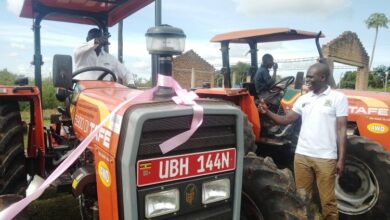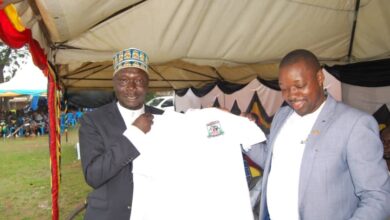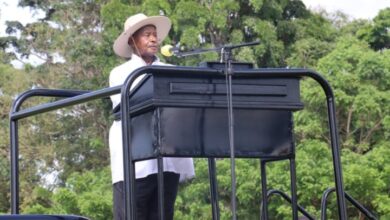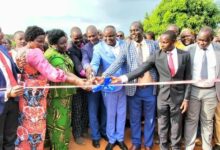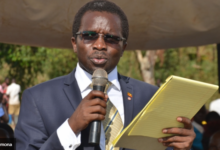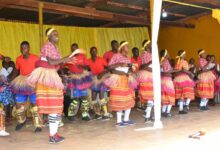Underground ivory trade threatens dwindling hippo population in Uganda and DRC
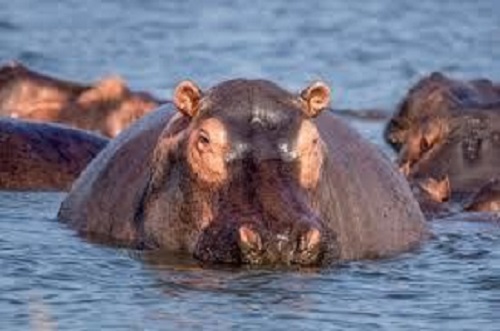
ARUA, September 25, 2023 – The hippopotamus in Africa’s Great Lakes is on the verge of extinction. The number of hippos is reducing in Lake Albert, at Murchison Falls National Park in northern Uganda, and Virunga National Park, eastern Democratic Republic of the Congo [ DRC ].
Over the last two decades, these hippos’ habitats have witnessed a 95 percent reduction in the number of hippos, one of the most dangerous animals in Africa. In 2022, Virunga National Park had 1,300 individual hippos, a 95 percent reduction from the number recorded in 1970. Murchison Falls is also grappling with the same challenge with fewer than 300 hippos remaining, according to the Uganda Wildlife Authority [UWA].
It’s not known how many hippos are left across Africa, but during the past few decades, this animal that has been labeled the continent’s second-most dangerous after the lion – more dangerous than elephants and Cape buffalo – has become increasingly threatened by hunting.
The International Union for Conservation of Nature [IUCN], which monitors the conservation status of species, classifies hippos as vulnerable because of threats of illegal, unregulated trade in their teeth, demand for their meat, and habitat loss. In 2016, in its last published assessment of hippos, the IUCN estimated their continent-wide numbers to be between 115,000 and 130,000. Since then, thousands have been legally and illegally killed for the domestic and international markets.
At Murchison Falls, some members of the local community, influenced by international traffickers, are allegedly involved in poaching hippos, according to Scovia Acan, a resident of Olwiyo trading center, Nwoyo district.
But the benefits are not fairly distributed, according to the resident, who said that traffickers put the lives of these poachers at risk, yet they buy the hippo teeth at a meager price of less than US$ 10 per kilogramme.
A former poacher, who has lived in Pakwach Municipality for more than 30 years, said that like elephant ivory, hippo teeth and tusks are often used for decorative carvings in Asia and European markets. They are cheaper and easier to obtain than ivory.
“This is why traffickers now prefer dealing in hippos’ teeth as opposed to elephant ivory, which is relatively expensive,” the informer who spoke on the condition of anonymity due to the sensitivity of the issue, revealed.
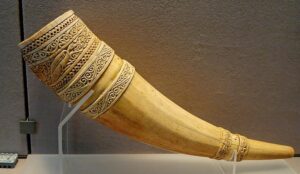
According to the World Wide Fund for Nature [WWF], hippos in Virunga National Park, eastern DRC are reported to be the most hunted for their precious canine ivory in East Africa. Out of more than 29,000 individual hippos recorded in 1970, fewer than 1,300 are reported remaining in 2022, according to Parc National Des Virunga.
The fate of the few remaining hippos in Virunga is also not guaranteed, given the presence of militiamen around the rivers and Lake Edward that serve as a habitat for these large mammals. These giant water and land animals are poached for their meat and the ivory contained in their teeth.
At Kyavinyonge fishery in the province of North Kivu, north of Lake Edward, which straddles DRC and Uganda, it was in the past unusual to find a small family of hippos of about 10 individuals, but this is a normalcy now.
The source of River Semliki is not far from the tourist site of Ishango, which also serves as a base for a unit of park rangers.
“Hippos tend to come close to humans where they find assurance of safety. Look where we come from; these animals spend their days not far from the landing site next to humans. Here, they are protected by game rangers,” Jackson Mumbere, a fisherman in Kyavinyonge fishery,” said.
Stéphane Paluku, a resident of Kyavinyonge, said he remembered hippos in “large numbers” in the 1970s when he lived together with his family at the shores of Lake Edward, which have since diminished.
“No one could venture alone around the lake, fearing to be killed by these animals. Incidents involving hippos killing people were so common. At that time, we were afraid of the hippos; whereas today, they are the ones who are afraid of us,” Paluku said.
Hippos impact on fisheries
Hippos influence freshwater food webs and can impact fisheries yield, according to a 2010 research on the status of hippos in Virunga National Park by Deo Kujirakwinja.
“Even though there have been no studies conducted on the contribution of hippos to fisheries productivity, they do import nutrients (urine and excreta) into aquatic systems, promoting phytoplankton growth and improving system productivity,” Kujirakwinja said.
He added: “Grazing activities of hippos alter the surrounding ecosystems, making them beneficial to other species such as warthogs and bush pigs, who take advantage of the grasslands created by grazing and over 14 species of birds that feed around and on hippos.”
The presence of the hippos also benefits tourism. According to Neema Nginga, a tour official at Kyavinyonge Fishery Tourism Service, the hippopotamus at Lake Edward is one of the species most visited by tourists. “Tourist guides and local traders here benefit from the hippos tourism. I find it necessary to protect them,” she said.
Despite the drastic drop in hippo population since the 1970s, the numbers started to increase again in 2005, according to Pascal Mbusa Muko, director of the Virunga Fisheries Cooperative [COOPEVI]. This was due to a successful awareness raising initiative by the fishermen’s cooperative with the support of the Virunga National Park, of which Lake Edward is a part. This included the creation of a radio on which they broadcasted reports, awareness workshops, as well as forums for popular expression.
According to Muko, the communications campaign intended to show the surrounding communities the benefits that can be drawn from the preservation of species, such as the fertility of the lake, increased youth employment in tourism, and other benefits to all of humanity from conservation.
Dataviz: Evolution of the hippopotamus population in Virunga National Park (1970-2022)
https://public.flourish.studio/visualisation/12717621/
Muko says that since hippo families are showing signs of recovery, there is also a positive change in the fish productivity of Lake Edward, and this is a good sign for the future.
Video: https://www.youtube.com/watch?v=6pWLF0PFJus
But in 2019, hippo numbers started to drop again due to activism by armed groups, which did not allow the park rangers to carry out their activities properly. This is an estimate according to the park, as the real count was not possible.
Currently, the population is around 1,300 pending a count which will take place at the end of the year. However, due to continuing armed violence, park rangers are still unable to carry out their activities normally within the park.
Arrests of traffickers
In February, June and July 2021, arrests of ivory traffickers were conducted in Butembo, one of the three main cities of the province of North Kivu in the DRC. This large shopping center is located near the Virunga National Park, near Lake Edward.
According to the police as reported by Mongabay, the suspects were in possession of around 30 kilograms of hippo ivory and two leopard skins. Those arrested were preparing to cross the eastern border into Uganda where they wanted to sell the trafficked wildlife products. It was the third arrest of wildlife traffickers in less than a year in Butembo.
In late 2021, in the same city, the Congolese Institute for the Conservation of Nature [ICCN] in collaboration with the police succeeded in arresting the militia leader Jackson Muhukambuto. Muhukambuto and his armed men in the territories of Lubero and Rutshuru, North Kivu [DRC], were accused of having killed 19 agents of Virunga National Park as well as numerous civilians and members of security forces during the various operations of wildlife trafficking, mainly ivory.
Congolese law severely punishes poaching of protected wildlife species, according to Valerie Lumande, a public prosecutor at Butembo High Court Prosecutor’s Office.
Video: https://www.youtube.com/watch?v=Zugph9N5pmQ
Hippo body parts can still be legally traded under the Convention on International Trade in Endangered Species [CITES], though most countries only offer permits for hippo ivory acquired from carcasses. This is a likely reason for continued underground trade, as traffickers seek for permits under the pretext of having acquired the tusks from carcasses.
Between 2002 and 2022, more than 84,000 hippo teeth and 2,500 hippo skins were exported from Uganda, according to the CITES Trade Database.
According to a TRAFFIC report, Uganda was the top country to export hippo products, contributing 40 percent of the worldwide trade between 2009 and 2018.
However, exports tracked by CITES have slowly decreased over the years.
Dataviz: Export of Hippo Products from Uganda, 2002-2022
https://public.flourish.studio/visualisation/14134126/
https://public.flourish.studio/resources/embed.js
Between 2009-2018, the European Union [EU] was one of the largest importers of hippo ivory, primarily going to Germany, Spain, France, Austria, and Denmark, according to the TRAFFIC report.
Data downloaded from CITES show that between 2002 and 2022, Hong Kong reported importing almost 90 percent of the hippo ivory exported from Uganda: about 75,000 teeth.
Hippo carvings are more popular in Asia because they are generally cheaper than elephant ivory.
Uganda has historically been known as a trading hub for wildlife and its products in East Africa, according to the Wildlife Conservation Society, due to the country’s porous borders, light penalties, and limited capacity to combat wildlife crime. However, the country is making stringent efforts in enforcement. This can be seen from the life sentencing of one called Pascal Ochiba, by the Uganda Standards, Utilities and Wildlife Court in October 2022 for possessing wildlife products.
Between 2018 and 2021, InfoNile and Oxpeckers Investigative Environmental Journalism tracked 28 wildlife crime cases in Uganda involving illegally poached hippo meat or teeth, published on the #WildEye Eastern Africa map, most arrested in western and northern Uganda.
While most cases were either still in court or had been convicted, punishments meted out ranged from fines of Shs 500,000 to Shs 3 million [around US$ 130 – US$ 800 ] or between 16 months and 5 years in prison.
The new 2019 Uganda Wildlife Act replaced the 1996 law, which conservationists said was weak because it set a maximum jail sentence of only seven years for poaching and wildlife trafficking. Now, convicts face a maximum fine of Shs 20 billion [US$ 5.4 million], life imprisonment, or both for poaching. Many conservationists look at the new law as a step ahead to conserve endangered species by having tougher punishment to discourage poaching and trafficking of wildlife products.
In DRC, the law classifies the hippo among the totally protected species. Regarding trafficking, the Congolese Institute for Nature Conservation has trained migration and customs agents to fight against trafficking. In March 2023, 30 rangers from Virunga National Park were sworn in before the public prosecutor as officers of the judicial police, which gives them the power to investigate cases relating to the trafficking of wild species, in particular hippos.
Trafficking routes
In our investigation, we discovered a passage which serves as an ecological corridor between Virunga National Park, eastern DRC and Queen Elizabeth National Park, western Uganda. This corridor, commonly called Kibumu, is located between the Congolese city of Kasindi-Lubiriha and the illegal fishery of Kasindi port. The route has become a porous track used by ivory traffickers, who use it to access the Kayanja fishery on the Ugandan side.
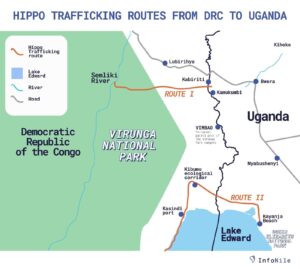 “Poachers and other traffickers use it without going through large cities or border crossings to avoid being caught by customs,” testified by an anonymous former park warden.
“Poachers and other traffickers use it without going through large cities or border crossings to avoid being caught by customs,” testified by an anonymous former park warden.
He added: “Traffickers use it night and day. Once in Kayanja, in Uganda, Congolese traffickers then contact their counterparts in Uganda who understand Uganda’s geography to finish the job. Two other routes used by ivory traffickers are Kamukumbi and Kabiriti, still located between the city of Lubiriha and the illegal fishery of Kasindi port. These two tracks lead to Nyavugando in the Bwera region of Uganda.”
To reach Kampala, the Ugandan capital, the ivory is carried away in baskets of fresh fish, whose carriers enjoy a certain favor because it is supposed to transport perishable goods, hence going unchecked by the authorities at the border. While there is no law exempting perishable goods from going unchecked, some authorities consider that the fish can rot if they hold the carrier for a long time.
From Uganda, the ivory is trafficked to the Indian Ocean coast in Kenya where it is then transported to Asia on the sea.
To try to control these porous tracks, park rangers from the Congolese Institute for Nature Conservation (ICCN) have set up an active patrol post at Vimbao. However, trafficking still continues.
On the Ugandan side, Bashir Hangi, the UWA communications manager, says that they have instituted checkpoints at Entebbe International Airport and major landing sites on Lake Edward, Lake Albert and Lake Victoria, but the several porous border points have allowed the illegal trade to continue.
Map showing Hippos distribution in Africa and Status Report by IUCN [2018]
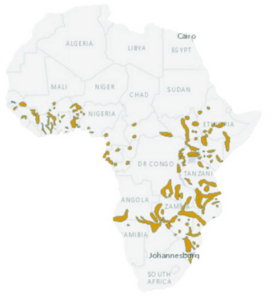
Support communities to mitigate poaching and ivory trafficking
According to a former poacher only identified as Harles, who is settled near Virunga National Park in DRC, a lack of projects that benefit the nearby communities around protected areas is one of the factors leading to poaching.
Harles stopped poaching after authorities killed and injured several of his fellow poachers. He believes that the involvement of the community is key in conservation.
“I personally killed a hippo as well as a few other animals in this Virunga Park,” he revealed. “Without a job, I find it unbelievable that I would be prohibited from hunting in the park, the only way to make quick money.”
“When officials recruit workers, they bring people from elsewhere; this is what pushes many to destroy wildlife and invade protected areas,” he added.
Bashir Hangi, the spokesperson of UWA, recommends the involvement of the community members near the protected areas in conservation. “The game guards and rangers cannot be everywhere. We need the support of the local community to protect these hippos. The benefit of conservation is for all of us. Let’s involve everyone in protecting the already endangered hippos,” Hangi said.
Conservation researcher Deo Kujirakwinja also advocates for an integrated conservation program including development projects, livelihood programmes and revenue sharing schemes.
With the support of WWF, UWA livelihood projects have been initiated to provide alternative food and livelihood sources to various community groups living near national parks, which has helped them leave poaching. These include support to beekeeping, apiary and fish farming projects.
In 2021, James Okware, the senior warden of Rwenzori Mountains National Park in western Uganda, was quoted by the WWF news team saying that UWA had signed a memorandum of understanding with groups including ex-poachers’ groups to promote “legal and regulated access and utilisation of resources from the park.”
The Congolese government and neighboring countries of Uganda, Rwanda and South Sudan should also set up common legal and border surveillance mechanisms to fight against poaching and hippopotamus trafficking, according to Claude Sengenya, an environmental journalist based in Butembo, DRC.
“We should also consider a technological revolution by implanting electronic tracking devices on hippos to allow park rangers to follow the movement of these large mammals,” Sengenya said.
In Uganda, Abdulatwaib Asiku, the chairperson of Yumbe district that borders South Sudan in the northwest, calls for the establishment of more customs border points in the West Nile region to reduce wildlife trafficking in this border area.
“We need to have more customs points in Busia, between Maracha and D.R Congo, between Koboko and D.R Congo, among others, to reduce on the porosity of our border,” Asiku recommended.
Steen Omito, the chairperson of Pakwach district, north of Lake Albert, said that East African countries should establish a similar response strategy to combat poaching.
“We need a joint conservation taskforce, where all the East African countries have representatives and jointly pull resources for operations,” Omito noted.
This story was produced in partnership with InfoNile with funding from JRS Biodiversity Foundation. Contributions from Jonas Kiriko, Annika McGinnis, Primrose Natukunda and Jonathan Kabugo.
https://thecooperator.news/uwa-to-surround-marchison-falls-national-park-with-electric-fence/
Buy your copy of thecooperator magazine from one of our country-wide vending points or an e-copy on emag.thecooperator.news

